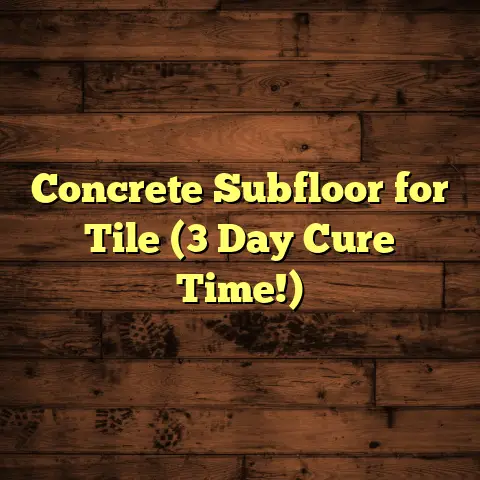How to Lay Hybrid Floating Floor? (1-Day Install?)
A Journey Through Time and Technique
Do you remember the floors of your childhood home?
I do. I remember the creaky hardwood in my grandparents’ place, echoing with laughter during family gatherings. Flooring isn’t just a surface; it’s the foundation of our memories, isn’t it?
Over the years, I’ve seen it all – from those classic hardwoods to linoleum, then laminate. And now, we’ve got hybrid floating floors, a fantastic blend of durability, style, and ease.
These floors are getting seriously popular, and for good reason. So, can you really install them in just one day? Let’s dive into the art of laying hybrid floating floors and find out!
Section 1: Understanding Hybrid
Floating Floors
Alright, let’s get down to the basics.
What exactly are hybrid floating floors?
Well, they are engineered planks typically made of multiple layers, often including a waterproof or water-resistant core (like stone polymer composite or wood plastic composite), a decorative layer that gives it the look of wood or tile, and a wear layer on top for protection. Think of it as the best of laminate and vinyl, all rolled into one super-durable package.
What are the benefits? Oh, there are many! I’ve seen these floors handle everything from spilled juice (thanks, kids!) to the heavy traffic of a busy household. They’re moisture-resistant, stable, and come in a huge range of styles.
Let’s compare them to other options, shall we?
| Flooring Type | Pros | Cons |
|---|---|---|
| Hardwood | Beautiful, adds value, can be refinished | Expensive, susceptible to moisture, requires specialized installation |
| Laminate | Affordable, durable, easy to install | Not water-resistant, can sound hollow, less realistic look |
| Luxury Vinyl | Waterproof, comfortable underfoot, easy to install | Can be dented, lower resale value than hardwood, appearance may not be as premium |
| Hybrid | Waterproof, durable, easy to install, realistic look | Can be more expensive than laminate, subfloor preparation is crucial |
As you can see, hybrid floors offer a sweet spot, especially if you’re worried about moisture or want a DIY-friendly option.
Now, the “floating” part is key.
Unlike traditional floors that are glued or nailed down, floating floors simply click together and rest on top of an underlayment. This makes installation much easier, and it also allows the floor to expand and contract with temperature and humidity changes – preventing buckling or gaps.
And what about the environment?
Many hybrid flooring options are made with recycled materials and are low in VOCs (volatile organic compounds), making them a more sustainable choice for your home. Always check the product specifications for environmental certifications, like FloorScore or GreenGuard.
Section 2: Preparing for Installation
Okay, so you’re ready to get started?
Awesome! But before you start clicking those planks together, proper preparation is essential. Trust me, I’ve seen too many rushed jobs end in disaster.
First, measure the space.
Accurately! I usually measure the length and width of the room at the longest points, then multiply to get the square footage. Add at least 10% extra for cuts and waste – you’ll thank me later.
Let’s say your room is 12 feet wide and 15 feet long: 12 ft x 15 ft = 180 sq ft. Adding 10% waste: 180 sq ft x 0.10 = 18 sq ft. Total flooring needed: 180 sq ft + 18 sq ft = 198 sq ft.
Now, gather your tools and materials. Here’s what I recommend:
- Hybrid flooring planks
- Underlayment
- Measuring tape
- Pencil
- Utility knife or flooring cutter
- Tapping block and mallet
- Spacers
- Straight edge or level
- Safety glasses and gloves
Don’t skimp on the underlayment!
It provides cushioning, sound insulation, and moisture protection. Choose one specifically designed for floating floors.
Acclimating the flooring is next.
Now, the subfloor. This is crucial.
The subfloor needs to be clean, dry, and level. I can’t stress this enough. Sweep, vacuum, and even mop (lightly!) to remove any debris.
If you have a concrete subfloor, check for moisture. You can use a moisture meter, or a simple test: tape a plastic sheet (about 1 foot square) to the floor and leave it for 24 hours. If moisture condenses under the plastic, you have a moisture problem that needs to be addressed before installing the flooring.
For plywood subfloors, check for loose or damaged areas. Replace any weak spots, and make sure all screws or nails are securely fastened.
Leveling is key.
Use a self-leveling compound to fill in any low spots or uneven areas. I usually use a long level to identify any dips or bumps, and then follow the manufacturer’s instructions for mixing and applying the compound.
Section 3: Step-by-Step
Installation Process
Alright, the moment you’ve been waiting for!
Let’s get those hybrid floating floors installed. Remember, take your time, be precise, and don’t be afraid to ask for help if you need it.
Step 1: Lay the underlayment
The underlayment is your floor’s best friend. It provides a smooth, cushioned surface for the planks to rest on, reduces noise, and helps prevent moisture from seeping up from the subfloor.
Roll out the underlayment, following the manufacturer’s instructions. Overlap the seams slightly and tape them together with seam tape. This prevents moisture from getting between the underlayment and the subfloor.
Step 2: Begin the first row
Starting along the longest, straightest wall is usually best. Place spacers (about ¼ inch thick) along the wall to create an expansion gap. This gap allows the floor to expand and contract without pushing against the wall.
Position the first plank with the tongue side facing the wall. Make sure it’s perfectly straight – this will set the foundation for the entire floor.
Step 3: Click and lock the planks
This is where the magic happens.
Most hybrid floating floors use a click-lock system. Angle the end of the second plank into the end of the first plank, then gently press down until you hear a click. This indicates that the planks are securely locked together.
Make sure the seam is tight and flush. If it’s not, use a tapping block and mallet to gently tap the plank into place.
Step 4: Continue laying additional rows
Staggering the seams is crucial for a natural look and added stability. I usually start each new row with a plank that’s at least 6 inches shorter than the plank in the previous row.
This creates a random pattern and prevents long, continuous seams that can weaken the floor.
When connecting the planks in subsequent rows, start by angling the long edge of the plank into the long edge of the previous row. Then, lower the plank down and click the end into place.
Step 5: Cut planks as needed
Inevitably, you’ll need to make cuts to fit around walls, doorways, and other obstacles.
Measure the space carefully, and use a utility knife or flooring cutter to make precise cuts. For intricate cuts, like around pipes, I often use a jigsaw.
Remember, measure twice, cut once!
Step 6: Install the final rows
As you approach the opposite wall, you’ll likely need to cut the planks to fit. Use the same techniques as before, ensuring you maintain the expansion gap along the wall.
In tight spaces, you might need to use a pull bar to lock the planks together. This tool helps you apply pressure to the planks when you can’t get a good swing with the tapping block.
Step 7: Add finishing touches
Now for the final flourish!
Remove the spacers along the walls. Install baseboards to cover the expansion gaps and give the room a finished look. Use a nail gun or construction adhesive to attach the baseboards to the wall, not the floor.
Install transition strips where the flooring meets other types of flooring, such as carpet or tile. These strips provide a smooth transition and protect the edges of the flooring.
I’ve found that a quarter round molding can also add a nice touch where the floor meets cabinets or other fixed objects.
Section 4: Maintenance and Care
Congratulations! You’ve got a beautiful new hybrid floating floor. But the job’s not quite done. Proper maintenance is essential to keep your floor looking its best for years to come.
Regular cleaning is key.
Sweep or vacuum regularly to remove dirt and debris. Use a damp mop with a pH-neutral cleaner specifically designed for hybrid floors. Avoid using excessive water, as this can damage the seams.
I recommend using microfiber mops – they’re gentle and effective at picking up dirt.
Dealing with scratches and scuffs?
Prevention is the best medicine. Use furniture pads under the legs of chairs and tables to prevent scratches. Place mats at entrances to trap dirt and debris.
For minor scratches, you can try using a scratch repair pen or a floor restorer. For deeper scratches, you might need to replace the damaged plank.
Humidity and temperature control is also important.
While hybrid floors are moisture-resistant, extreme humidity or temperature fluctuations can still cause issues. Maintain a consistent temperature and humidity level in your home to prevent excessive expansion or contraction.
A dehumidifier can be helpful in humid climates, and a humidifier can add moisture to the air in dry climates.
Periodic inspections are a must.
Keep an eye out for any potential issues, such as gaps, buckling, or loose planks. Address these problems promptly to prevent them from worsening.
If you notice a gap between planks, you can try using a tapping block and mallet to gently tap them back into place. If a plank is loose, you might need to replace it.
Conclusion
So, did you do it? Did you install your hybrid floating floor in just one day? I hope so!
There’s a real sense of satisfaction in completing a project like this, isn’t there? Not only have you enhanced the beauty of your home, but you’ve also embraced the spirit of innovation in flooring technology.
Your new hybrid floating floor is more than just a surface; it’s a testament to your hard work and a foundation for countless memories to come. Take pride in your accomplishment, and enjoy your beautiful new floors for years to come!





